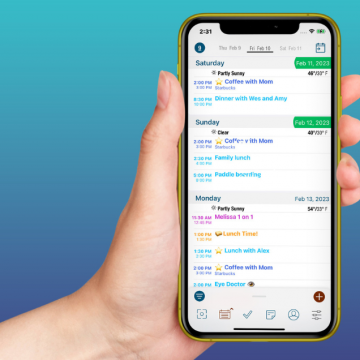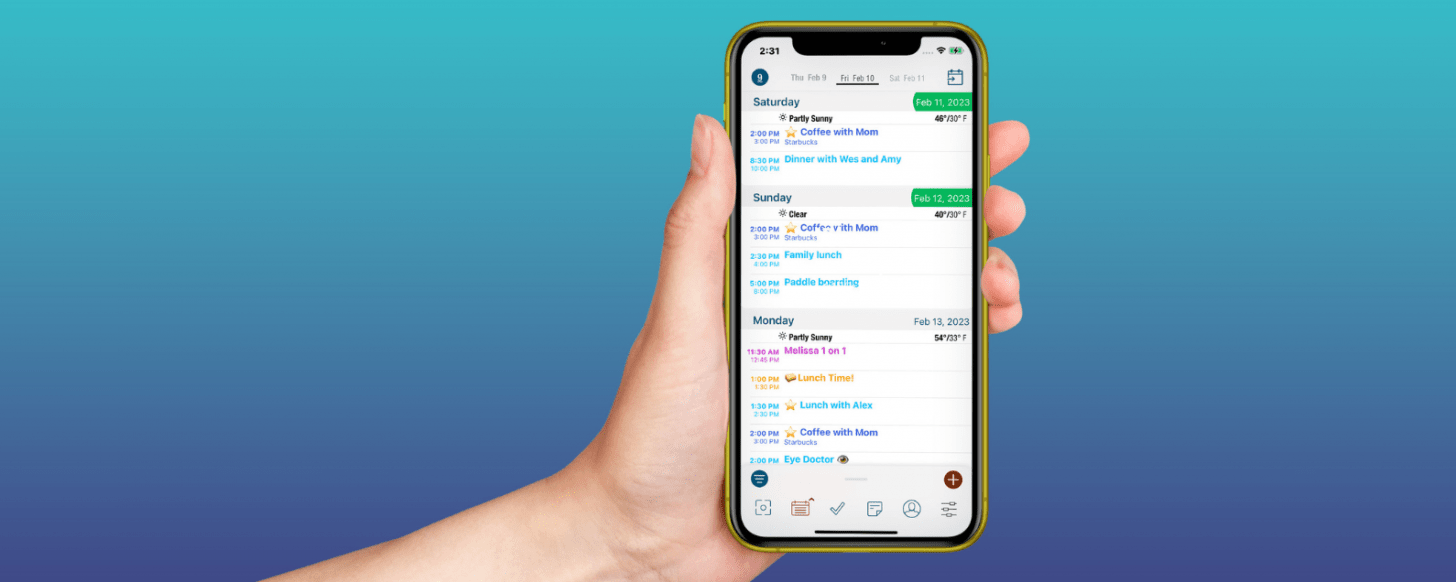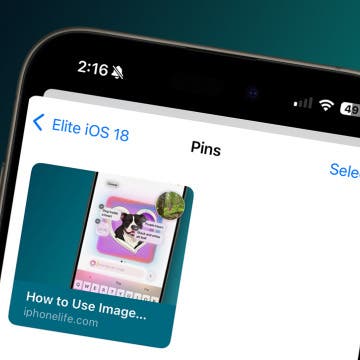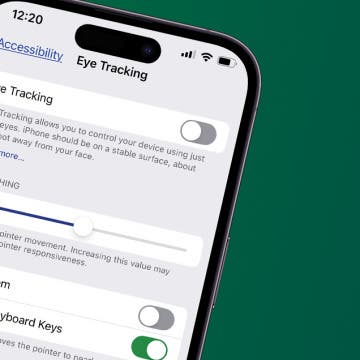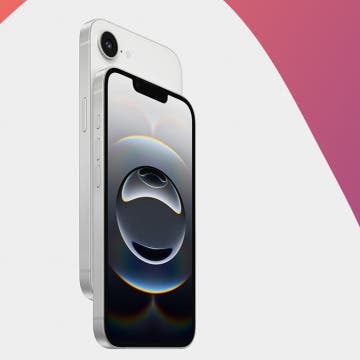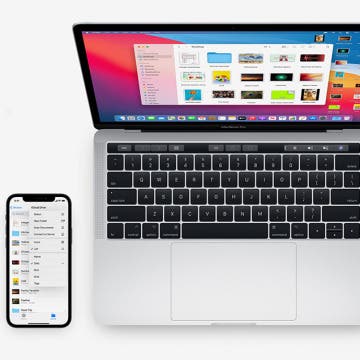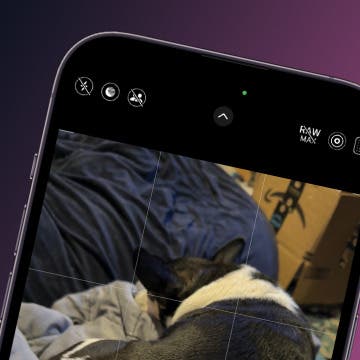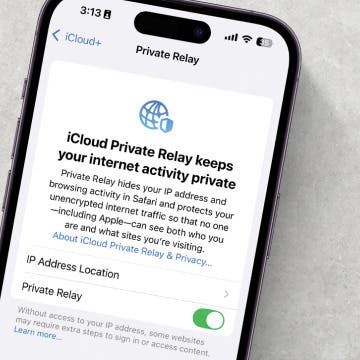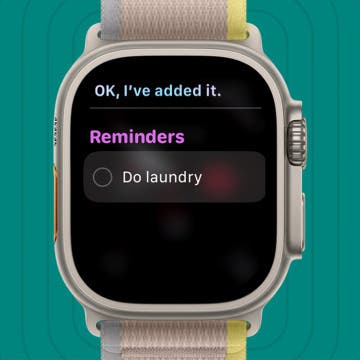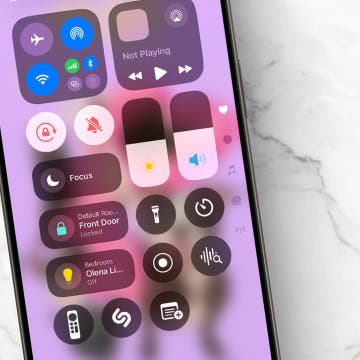
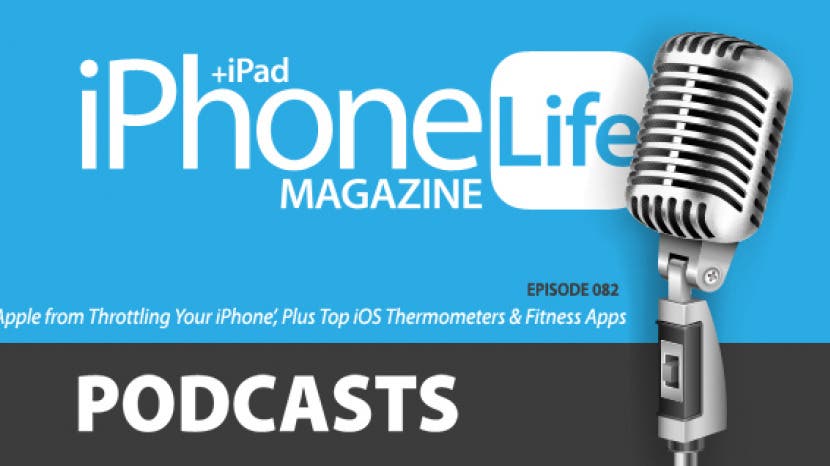
In the 82nd episode of the iPhone Life Podcast, the team teaches you how to take control of your battery health and phone speed with iOS 11.3. Other topics include Sarah's favorite iPhone-connected thermometer and the fitness app everyone at iPhone Life is talking about.
Click here to listen and subscribe. If you like what you hear, be sure to leave a review. And remember to tune in every other week to hear our editors share with you the latest Apple news, best apps, iPhone tricks, and coolest accessories.
This episode is brought to you by Matias. Matias raises the bar for all other keyboard manufacturers with its Wired RGB Backlit Keyboard ($99). This aluminum keyboard comes in a variety of attractive colors and includes a full-sized numeric pad. Get one today!

This episode was recorded using high-quality mics from Blue Microphones.
Question of the week:
What, if anything, do you think Android does better than iOS? Email podcasts@iphonelife.com to let us know.
Articles referred to in this episode:
- How to Turn Off Throttling on iPhone with iOS 11.3
- Embarrassing Tech Mishaps: The Shattered iPhone Edition
Apps & gear referred to in this episode:
- Aaptiv ($14.99/month)
- Kinsa QuickCare Thermometer ($19.99)
- Kube
Useful links:
- Become an iPhone Life Insider
- Sign up for the free Tip of the Day Newsletter
- Email the Podcast
- Subscribe to iPhone Life magazine
Transcript of Episode 82:
Donna Cleveland: Hi, and welcome to episode 82 of the iPhone Life Podcast. I'm Donna Cleveland, Editor in Chief at iPhone Life.
David Averbach: I'm David Averbach, CEO and Publisher at iPhone Life.
Sarah Kingsbury: I'm Sarah Kingsbury, Senior Web Editor at iPhone Life.
Donna Cleveland: Each week we bring to you the best apps, great gear, and top news in the iOS world. This episode, we want to start out by telling you about our sponsor, Matias. We have their keyboard right here that David's going to tell us about.
David Averbach: Yeah. Matias is a company, they just make keyboards and I love companies like that because they get so passionate about their one product. They have a wide range of keyboards available, so one of the ones we talk about frequently is their Bluetooth keyboard. The one we're going to talk about today though is actually the wired keyboard. Apple has discontinued producing the wired keyboard now, which some people love the Bluetooth keyboard. I actually have a Bluetooth keyboard at my desk.
David Averbach: What's great about Matias' Bluetooth keyboard is that it can A, connect to up to four devices as opposed to Apple's, which can only connect to two, and B, the battery life lasts for a year, but even so, sometimes Bluetooth can ... all Bluetooth can have connectivity issues. If you just have a keyboard that you want to just plug into your computer all the time, it can easier to not have to deal with charging your keyboard, even if it's only once a year and also, it can be easier to just plug it in so you don't have to deal with reconnecting your keyboard every time you turn on your computer, even though it happens by default.
David Averbach: This is a great option for a lot of people. For the record, I'm actually planning on switching to this option. It's a wired keyboard, has a numeric keypad, and what's cool about it is not only does it come the range of colors that Apple offered, but also it has back lighting and you can actually change the tone of the back lighting, so you can change it to adjust depending on your preference. Some people like to have a blue back lighting depending on the room tone, things like that, so really great option for people who want a third-party keyboard.
Donna Cleveland: We met with Matias when we were at the Consumer Electronic Show earlier this year and one use that they pointed out for the back lighting was that you can set the back lighting at night to be more of a mellow, warm tone because that doesn't interfere with your, what is it?
David Averbach: I think it's melatonin.
Donna Cleveland: Yeah. There's something with your circadian rhythms that is interrupted by having blue light at night.
David Averbach: Mm-hmm (affirmative).
Donna Cleveland: You can have kind of a cooler light during the day and just switch the little knob to have a warmer light in the evening. I thought that was useful.
David Averbach: Yeah, and the back lighting in general is really nice to be able to have at night. I am, for the record, switching from the Matias Bluetooth to this keyboard and I'm very excited about it.
Donna Cleveland: Can I have your Bluetooth keyboard for my desk?
David Averbach: Probably. I also might keep the Bluetooth one for my iPad because you can use it with the iPad. I'm getting a new iPad, so this is getting way off track. Check out Matias.
Donna Cleveland: Yeah. Check out Matias. Moving right along. We have a tip for you that I think you're going to be excited about and that's how to turn off battery throttling. We've, in a few episodes ago, we talked to you about this whole controversy over Apple slowing down your processor in order to keep your phone more stable. Well, Apple, along with offering steeply discounted prices on new batteries, has also just rolled out a new feature with iOS 11.3 that allows you to control whether or not Apple slows down your phone or not. If you go to settings, battery, there you'll see at the bottom ... Okay, disclaimer. If you have an older phone, you'll see this at the bottom.
David Averbach: Important caveat, important caveat.
Donna Cleveland: If you have an iPhone 7 or older, at the bottom you'll see a throttling battery option and you'll see in a little blue wording it will say “disable.” It's not like a big knob that you turn or anything like that, so it's something you have to look out for. Once you've disabled iPhone throttling, your phone will not slow down to keep your phone more stable. It may crash more though, so it's something, if you decide to disable this, you want to keep an eye on how your phone is doing. If you can go to iPhoneLife.com/dailytips, you can sign up to get more tips like this. We'll have lots of battery saving tips as well as all other topics of things you can do to get the most out of your iPhone, iPad, Apple Watch, etcetera. We wanted to tell you about that. Also, let us know how your battery is doing from enabling this feature. You can email us at Podcast@iPhoneLife.com. We always love to hear from you.
Donna Cleveland: Moving right along, that's our daily tip for the week. We also want to tell you a little bit about our insider program. iPhone Life Insider is our premium subscription and when you sign up, you get basically all of the information you could ever need about your iOS devices to help you get the most out of them. You get video guides, you get a video version of our daily tips, so if you have a hard time finding things in settings or just in general, you can watch a video that shows you how to accomplish these tips and more in a really easy way.
Donna Cleveland: We also have a feature called Ask an Editor where you, if you're having a specific iOS problem, you can email Sarah and she'll respond and let you know how to solve your issues. Each episode we like to share a recent question from an Insider and I'll let Sarah take it away.
Sarah Kingsbury: The question I received this week was an Insider was reading or watching a video of a tip about the battery widget in the Today view. If you have like an Apple Watch, you can see just quickly the battery levels of that, which seems like well I could just look at my wrist, but I have found during the winter it's actually easier just to look at the Today view than push my sleeve up out of the way of my watch. Anyway, I think this particular Insider got to the point in the tip where he went to his Today view and then didn't see the battery widget and stopped following the tip and wrote to me, which it's always a good idea to go through because sometimes we say things like, “If you don't see this option, do this.” Here is the part of the tip that this reader missed.
David Averbach: This is our weekly Insider shaming session section of the podcast.
Sarah Kingsbury: No, no. Like I can understand ...
David Averbach: Make sure you read the tip ... No, go ahead, go ahead.
Sarah Kingsbury: [crosstalk 00:06:59] sometimes like not, for instance with the throttling, not every phone will have that option, so that can be frustrating if you want to follow the tip.
David Averbach: Mm-hmm (affirmative).
Sarah Kingsbury: If you, and this applies for any widget. If there's some sort of widget, some sort of thing ... Widgets are basically shortcuts into an app. In the Today view, they have just a teeny bit of the most useful information related to that app and you can tap on it and then open up the app and go further. What you do is you go to the Today view, which used to be like the spotlight or Siri suggestion screen, but now Apple calls it the Today view. From the first home screen on your phone, you swipe right and that will bring up the Today view. Then, scroll down to the bottom and tap edit. I just explained all of this to David, actually, and then there will be two lists.
Sarah Kingsbury: There will be a list of all the widgets that are already enabled and then below that will be a list of all the widgets that you can add with a little green plus sign next to them. You can find the battery one there and tap that. Then it will be one of the widgets. You can also, while you're there, see other cool widgets and add them and remove ones that aren't useful. There's a little, three horizontal bars to the right of each widget that's included on your iPhone. You can press and hold on that and move it up and down and reorder your widgets. I find if I remember to use it that the Today view, once you customize it, is extremely useful.
David Averbach: I was just going to ask, so you use your widgets in your Today view pretty frequently, Sarah?
Sarah Kingsbury: I would say yeah.
David Averbach: What widgets do you use?
Sarah Kingsbury: Let's see.
Donna Cleveland: Yeah, I was going to ask which one's you guys put at the top of your Today view. For me [crosstalk 00:08:47] weather.
David Averbach: [crosstalk 00:08:47].
Sarah Kingsbury: I have a Find Friends at the top, which I'm considering relocating further down because sometimes I open up my Today view and then I'm like, “Oh, David's in Chicago,” because we share location with each other, but I don't-
David Averbach: That's the most important for Sarah's iPhone is ...
Sarah Kingsbury: Yeah.
David Averbach: ... making sure that I'm in Chicago.
Sarah Kingsbury: It's not actually like information I really need and also it feels weird to know that about David. I have Find My Friends, which I mostly use for my kids. I have batteries, I have the weather because that's easier than opening up the weather app. I can see the hourly weather and things like that. I have my calendar. I have my reminders. I have the Clue app. I have my favorite contacts and I have my favorite contacts set up so that there's a default way to contact them. Some people, if I tap on them, I'll automatically place a phone call. Other people automatically open up a message.
David Averbach: Wow.
Sarah Kingsbury: I have music, so I can go to like playlist or albums that I listen to frequently and then just Siri app suggestions, which are the apps I use most frequently. Then, my data because my kids don't understand that you pay for data and so I have to monitor their usage. Just things like that.
Donna Cleveland: Wow. I think you use widgets more than I do.
David Averbach: I'm really impressed.
Donna Cleveland: I use like weather, that's about it.
David Averbach: I don't use it at all. I'll tell you what I have because every once in a while, I'll feel inspired that I think that I'll decide to start using it and then I don't, but I have weather and then I have my move goals, so I don't have to look at my watch. Then, I have the podcast, which Sarah, I think you were the one that told me to add that and I really like it because it has my top podcasts I listen to ...
Sarah Kingsbury: I have that too.
David Averbach: ... and I can click into it really quickly.
Donna Cleveland: That sounds nice.
David Averbach: I added the battery one for this tip while Sarah and I were talking about it beforehand, so I will let you know if I use any of this.
Sarah Kingsbury: There's a lot of features that Apple has that nobody uses because you have to customize them, but once you customize them, they can be really useful. Like, if you remove all the widgets that are irrelevant to you and really pay attention to what you put in your Today view and what order you put them in, it can actually make your life really easy.
David Averbach: There's something particularly funny to me about widgets in that before Apple came out with them, it was this really big thing that Android had an Apple iPhones don't have. It's like a selling point for Android. Then, Apple's like, “All right, fine, widgets.” I don't think very many people use them. I don't use them very much, even though I talk about them a lot ahead of time because it was like a thing people cared about. I don't know, it's funny.
Donna Cleveland: Yeah, it is funny. I do think that they're somewhat useful the way they are, but I also feel like Apple incorporated them in a way that's not really the same as Android widgets.
David Averbach: Yeah, that's fair. That's fair.
Donna Cleveland: That's like the one area where I feel, where I personally feel like Android does a better job.
Sarah Kingsbury: [crosstalk 00:11:50] case, I'm an Apple fan, but when I did ... We had Android Life here for a while and I used a Samsung Galaxy phone and the widgets were really nice.
David Averbach: Really?
Sarah Kingsbury: Yeah.
David Averbach: Okay.
Donna Cleveland: You know what I would like? Based on my experience with the Apple Watch, is I would like to be able to customize my lock screen, so I could just see the weather there or ...
David Averbach: Yeah.
Donna Cleveland: I mean, like I guess that's what the Today view is, but [crosstalk 00:12:13].
Sarah Kingsbury: [crosstalk 00:12:13] do that.
Donna Cleveland: I just want the screen to wake up and I can look at it and be like, "Oh, it's 34 degrees and raining outside," I don't want to have to go to the Today view and scroll down to that widget.
Sarah Kingsbury: Well, in [crosstalk 00:12:21] that's our sad reality. It's 34 degrees and raining outside, yep.
David Averbach: In April. Also, what Android does, to my understanding having never used an Android phone really, is that on the home screen you can have a combination of apps and widgets in one view. Is that [crosstalk 00:12:37].
Donna Cleveland: Yeah.
David Averbach: That, I think I would like, too, I hate to admit when Android does something well, but I think I would like that because I have so many apps on my home screen and I use like 10 of them every day and the rest I very rarely access. I'd be willing to get rid of some of them and replace them with like a weather widget on the home screen.
Donna Cleveland: I think and interesting question of the episode should be what do you guys think, if anything, that Android does better than iOS?
David Averbach: Yeah. Also, what widgets are you using?
Donna Cleveland: Yeah, so email Podcast@iPhoneLife.com. You can let us know either of those things or anything else that you want to talk to us about. Now, I want to move into our new section of the podcast called Tech Mishaps. Here, we get our listeners and our readers in the magazine to share some of their funny mix ups. We've all had them and some of them are more shareable than others, but here I wanted to share a story that someone shared with us.
Donna Cleveland: “I was texting my boyfriend some scantily clad photos while he was away on a trip. While I was sending a photo, my ex happened to text me. Somehow, I must have clicked on something that indicated I wanted to send him the photo, rather than my boyfriend. Much to my dismay, my ex opened the picture. Needless to say, he was not pleased. Fortunately, my boyfriend and I found humor in the incident.” That is one example of a Tech Mishap that can happen. I feel like we've gotten stories, everything from people dropping their phone in a puddle to ...
David Averbach: That's was me I think.
Donna Cleveland: Yeah. Texting their boss something meant for their friend, so if you have a story like that, email us at TechMishaps@iPhoneLife.com and we will keep your story anonymous. Don't worry, so we look forward to having a laugh over the stories you guys submit.
David Averbach: Laughing with you, not at you.
Donna Cleveland: Yes, exactly.
David Averbach: Most of the time.
Donna Cleveland: Yeah. Next up, we're moving into Apple Complaints and Learning. Here we'll share either something we've learned recently or something with Apple's iOS that we are wishing could change. Do you guys have any complaints and learning?
Sarah Kingsbury: I have a couple.
Donna Cleveland: Okay.
Sarah Kingsbury: My complaint is you used to be able to in your settings, and I can't remember if it was in photos or in messages settings, choose to save or not save like automatically any photos you took within the messages app. I decided recently, I had turned that off, and I decided recently that I wanted to turn it back on and start having these photos that I take in my messages app automatically get saved to my photos, but that option's gone. There is a workaround. Instead of when you tap the camera icon in the messages app, instead of just using that little camera window that pops up ...
Donna Cleveland: Or like mini viewfinder.
Sarah Kingsbury: ... like just do a little swipe to the right from the left edge of the screen and they'll be a camera icon and you can just open your camera app directly from there and take the picture that way. Then, it will be saved, but it's annoying and it's an extra step.
Donna Cleveland: That is annoying because you essentially have to leave the messages' app instead of doing it all right there.
Sarah Kingsbury: Right, so that's my complaint and then my learning is I wear my Apple Watch all the time and I don't lock it like I should before I get in the shower. Sometimes, because I have the workout complication on my watch face, I'll get out of the shower and discover that my watch has been tracking me doing elliptical workout for the last five minutes. I don't really want those to be in my workout history. I like to go back and look at my workout stats for the month and stuff, but I couldn't figure out how to delete them. When you go to that workout in your workout history for that day, there's no option to delete it, but if you go to the workout tabs in your activity app instead and look at your list of workouts for that month, if you swipe left on that five-minute elliptical workout, then you can just delete it that way. Then, you can choose whether to delete the workout or delete the data associated with it. In other words, the number of calories you actually didn't burn and the number of exercise minutes you actually didn't do. That's what I learned.
David Averbach: [crosstalk 00:17:02].
Donna Cleveland: Have you ever had that happen to you where it's like you had an accidental workout or tracking [crosstalk 00:17:09]?
David Averbach: No.
Sarah Kingsbury: That's never happened to me.
Donna Cleveland: Remember?
Sarah Kingsbury: Oh, recently I took my daughter and a group of kids to the mall. I don't know how it happened. I think it was because it was very cold and snowy and I had my jacket sleeve covering my watch, but after sitting in a Barnes & Noble for a couple of hours drinking coffee and reading a book, I checked my watch to see what time it was and discovered I'd done a strength training workout and a yoga workout and had supposedly burned, I can't remember, like many hundreds of calories ...
Donna Cleveland: This is a good Tech Mishap.
Sarah Kingsbury: ... and this like major workout that I did not do and I don't know how I burned that many calories sitting in a book store.
David Averbach: What's funny about it too is that we all get notified when Sarah works out, so we're all getting these really impressive workouts that she's doing while she's sitting in Barnes & Noble drinking coffee.
Donna Cleveland: Yeah. [crosstalk 00:18:02]
Sarah Kingsbury: I did legit run and do yoga yesterday, just so you know.
David Averbach: Okay, okay.
Sarah Kingsbury: That was not a fake one.
David Averbach: That doesn't happen to me because A, I don't wear my Apple Watch in the shower, and B, I don't think I can start a workout from my ...
Sarah Kingsbury: It's only because I have the workout complication.
David Averbach: Yeah.
Sarah Kingsbury: Which is why it's my fault and so that's not a complaint.
David Averbach: Doubly your fault.
Donna Cleveland: It's just funny.
David Averbach: What happens to me all the time is I will forget to turn off the workout when I'm done and so it will be like long. An extra hour of working out before I realize.
Donna Cleveland: That's happened to me.
Sarah Kingsbury: Do you know what happened to me? I did an entire rowing workout and I was like, “Oh, that was so hard,” and I went to stop it and I hadn't pressed start.
David Averbach: Oh, I hate that.
Donna Cleveland: That's the worst. It makes you realize how much that little like getting credit for it really matters in your psychology.
David Averbach: How much of a motivational factor it is. Yeah.
Donna Cleveland: Yeah. I've got a complaint. I'm curious if you guys have this problem, too. I use Siri all the time to schedule things with calendar and I've notice that whenever I schedule something with another person, Apple wants to send an invite to that person, but a lot of times that's not what I want. Like, I want to say I'm having lunch with, like schedule lunch with Sarah Thursday, but really, I don't want an invitation to go to Sarah. I just want it and then something will pop up, being like, “Which Sarah?” There will be four Sarah's to choose from and I'm just like [inaudible 00:19:25], but if I don't say, “Lunch with Sarah,” there's no way for me to remember. I don't want to just say, “Schedule lunch.”
Donna Cleveland: The way that this came up that was really annoying is that as a Valentine's gift, I got my husband a massage and I scheduled it for him, so I said schedule a [inaudible 00:19:42], you know, I wanted to remember when it was. Schedule a massage for Tyler this day and so it sent him an invitation to it. This was like a few days ahead of the time, so he like text me being like, “Did you mean to send me an invitation to a massage?”
David Averbach: Such a bummer.
Sarah Kingsbury: Siri spoiled the surprise.
Donna Cleveland: Yeah. I don't [crosstalk 00:19:59] ...
David Averbach: That's a good Tech Mishap, too, actually.
Donna Cleveland: ... see any way. Yeah, I guess that's true. I don't see any way to turn that off in Siri. Like, that just seems like something you have to deal with.
David Averbach: Yeah, and I've actually ... Sometimes what will happen is it will send it to the wrong person. Like, it will pop up and ask ...
Donna Cleveland: Yeah, [crosstalk 00:20:15] too.
David Averbach: ... you the people, but sometimes if you have one person in your phone under that name, but you're scheduling with a different person who isn't in your phone, it will just send it to the one person in your phone and it's really annoying and you have to email back and forth to the person that actually I didn't mean to invite you and all this ...
Donna Cleveland: It seems like buggy enough, like not well thought out enough that it just shouldn't be a feature. If it worked really well, it seems like that would be kind of cool if you can just manage your schedule that easily, but I mean, I just [inaudible 00:20:45]. I'm thinking they are probably a lot of people out there like me first of all, who are not wanting to send an invitation and then secondly, usually you have more than one contact in your phone with the same name.
Sarah Kingsbury: Well, I found Siri has taken to asking me, like I will ... There's a contact I have who is the only contact with that name and when I say to Siri call this person, they're like, “To be clear, do you want to call this person?” I'm like, the only one in my phone. Come on.
David Averbach: Yeah, you know why. Siri really doesn't want to call the wrong person.
Sarah Kingsbury: Usually, it's annoying because when I'm using Hey Siri, I'm using it because I'm doing something else and I don't want to be distracted. Having an extra step added creates a distraction at a time when I really need there to not be a distraction.
Donna Cleveland: Yeah, it kind of defeats the whole purpose.
David Averbach: This is exactly, for the record, why Apple can't win. It's like, if it asks you, it annoys Sarah and if it doesn't ask you, it annoys Donna.
Donna Cleveland: That's true. Fair enough, David.
David Averbach: Yeah. Okay, I've got one, too. I don't know if this happens to you guys. I think it is kind of a universal Apple bug where if I start a new text message, as opposed to tapping on somebody who's already in my thread, and I start typing, if I either navigate away from the messaging app or I close my phone and reopen it, that message goes away before ...
Sarah Kingsbury: That doesn't happen to me at all.
David Averbach: Really? Before you send it?
Donna Cleveland: Yeah, that doesn't happen to me either. Usually it will be there.
David Averbach: Oh, wow.
Donna Cleveland: That's so weird.
David Averbach: It happens to me all the time and especially because I have my go to sleep mode pretty aggressive, so sometimes I'll be typing and then somebody will ask me a question, I'll look up or, you know, often I'll try to look something else up that I'm texting about. Trying to figure out what time to eat for brunch or whatever, and then I'll look down and my phone will be off and I'll open it back up and the message will be gone.
Sarah Kingsbury: Maybe I ...
David Averbach: It drives me crazy.
Donna Cleveland: That's very annoying.
Sarah Kingsbury: I have like auto sleep turned off.
David Averbach: Maybe it's auto sleep.
Sarah Kingsbury: I think it's the sleep because [crosstalk 00:22:45] say, I've had instances. I was trying to think when is it that I've lost a message I was writing. Most of the time when I go back, it will be there, so that would be worth looking into. Is it [crosstalk 00:22:55] your phone to sleep?
David Averbach: I think maybe it is. Maybe when I navigate away I can navigate back and so maybe it's just a sleep function. Certainly, I think my solution is going to be to make it a less-aggressive sleep function, but it's still a really annoying feature that it just disappears because it happens a lot too when I'm sending out a group message, which I'm often texting complicated instructions to something. I'll type it all out and then I'll go try to fix something and I'll come back and it will be gone and I'll have to do it all over again and create the group all over again and all that.
Donna Cleveland: One thing that this made me think of is just like a lot of times I will spend quite some time drafting a message as well and I really don't like that pressure of knowing that everyone else can see like the little three dots moving so they can tell Donna's writing something.
David Averbach: Yeah.
Donna Cleveland: Especially, yeah, if you're, just depending on the conversation, you don't really want people to know that you're spending all this time typing something out. Right?
David Averbach: Well, you also, like, I'll often, if I'm doing that, I'll write it in notes for that reason.
Donna Cleveland: It's like why does Apple even have that feature?
David Averbach: I mean, there's times when it's nice.
Donna Cleveland: Is it useful?
David Averbach: Yeah, if you know, like, I like it in reverse. I don't like that they show that I'm typing, but I like to see that somebody's typing.
Donna Cleveland: Well, I guess it lets you know that the conversation is continuing, so you know to stay there instead of being like ... I mean, that's the only thing I can think of, of why it's really a useful thing.
David Averbach: Yeah.
Sarah Kingsbury: I really like that because it's usually the more serious conversations where you kind of don't want them to know you're spending five, 10 minutes reworking it.
Donna Cleveland: I know.
David Averbach: Especially because you end up sending like one sentence.
Donna Cleveland: Right.
Sarah Kingsbury: [crosstalk 00:24:30].
David Averbach: You're like [crosstalk 00:24:30] 20 minutes crafting that sentence.
Donna Cleveland: Or decide to take a break and think about it. I really like that my boyfriend has an Android and can't see those dots.
Sarah Kingsbury: Yeah. Good call.
David Averbach: [crosstalk 00:24:41] See, to me it's all about writing it in notes because also, I've had it happen to me, especially in these sensitive conversations, which really you shouldn't be having over text message anyway, but I sometimes do, when you accidentally hit send before you mean to and then it's like you haven't crafted it right or it's just not right.
Sarah Kingsbury: [crosstalk 00:24:57].
David Averbach: Right.
Sarah Kingsbury: One time I was really angry at someone I was dating and I wrote this whole email to get it out of my system. Like, I'm breaking up with you and then, like ...
David Averbach: Oh, man.
Sarah Kingsbury: ...went to delete it and sent it.
Donna Cleveland: Okay, why has this not gone into our Tech Mishaps. This is amazing.
Sarah Kingsbury: This happened over 10 years ago.
Donna Cleveland: That's okay, a Tech Mishap.
David Averbach: Did you stand by it or were you like [crosstalk 00:25:19]?
Sarah Kingsbury: Yes, I meant that.
David Averbach: Yeah, I didn't mean it.
Sarah Kingsbury: I should have stood by it.
David Averbach: Okay.
Sarah Kingsbury: I married him and divorced him.
Donna Cleveland: Oh, wow. That's a pretty good Tech Mishap.
David Averbach: That is a great Tech Mishap.
Donna Cleveland: Okay, moving into our Apps and Gear section because we could be here all day.
David Averbach: Mm-hmm (affirmative).
Donna Cleveland: We wanted to share some of our favorite apps and gear right now. Mine is Active and I've been telling other people in the office to use it, too. Sarah, have you used it yet?
Sarah Kingsbury: I downloaded it and I'm totally going to do the free trial.
Donna Cleveland: Active is a workout app that is a monthly membership, but you do get a free month trial. Well, I don't know that everybody gets a free month trial. We get a free month trial I think for press.
Sarah Kingsbury: No, there's just ... I didn't download it as a press person.
Donna Cleveland: Oh, really?
Sarah Kingsbury: There's a 30-day trial. Yeah.
Donna Cleveland: Oh, okay. Thought I was getting special treatment, but I guess I'm not.
David Averbach: No, not that special.
Sarah Kingsbury: You're not special, sorry.
Donna Cleveland: Special snowflake. It's $14.99 a month after that, so this is something, you know, it's a little bit expensive, but if you're comparing it to a gym membership, it's not. It has a lot of different workouts. I tried out a couple of yoga ones, but there is running workouts, cycling, all different kinds of activities that you can ... You can wear Bluetooth earbuds and you'll have a coach basically in your ear and music already picked out to guide you through your workout. I really liked the yoga class. It thought it was great.
David Averbach: That's cool.
Sarah Kingsbury: I was looking through the workout options though and there was one workout I thought would be interesting, but it was to country music and I was like, “That's not going to happen.” That's a little bit of a problem.
Donna Cleveland: You can't [crosstalk 00:26:49]. They have a big enough library though that for instance, with yoga I thought it would be fun. All the classes in town are kind of like soothing music, so I did some hip-hop workout, yoga workouts, but that was like a few of the videos they had and then they had tons of other ones. I think there's enough that you can just steer clear of the country music without being without deprived.
Sarah Kingsbury: Yeah, I found a similar one, but ...
Donna Cleveland: Yeah.
David Averbach: I've been using, I think I mentioned this in a recent podcast, Peloton, which is I think they seem like they're moving into very competitive spaces.
Donna Cleveland: Yeah.
David Averbach: Peloton started as just being for spin class, but now they have yoga and core workouts as well and I haven't tried the yoga, but I've been enjoying the spin workouts.
Donna Cleveland: That's a lot more a month, isn't it?
David Averbach: No, it's $12.99 a month.
Donna Cleveland: Okay, yeah.
David Averbach: It's cheaper, Donna.
Donna Cleveland: Wow.
Sarah Kingsbury: Is it just bike, spin, and yoga?
David Averbach: They have core workouts as well. They don't have running workouts. One of the things I like about it is they have a studio in New York and so they have live classes that you can tune into or they will put them up later so you can watch them. There's something to me about, like I really enjoy going to live classes more so than having the kind of typical TV workout. I've been enjoying that about it as well.
Sarah Kingsbury: Yeah, I'm excited to try their rowing workouts and their strength training workouts because I have been ... every once in a while, I can get up going to a CrossFit workout with Donna, but I also like to strength train on my own, so I'm excited to try this.
Donna Cleveland: Yeah, I'm a really, personally I'm very motivated by group classes, but I know a lot of people aren't like that, so this would be an app I would use as a supplement to a membership. I think for a lot of people who don't really like socially working out, having something like this that makes you still feel like you're part of a class and you don't have to think about it, you just go, it's a really great thing.
Sarah Kingsbury: It's also great for just timing. Like sometimes I was supposed to be in a yoga class right now but recording it didn't work out. If I did it on the app, I could still go and be in a yoga class.
Donna Cleveland: Yeah.
David Averbach: Also, like sometimes I'll just want to do a quick 20-minute workout or something like that and then it takes me, by the time I get changed, go to the gym, come back, it adds an extra 10-15 minutes to the process that if you do it at home is really nice to just not add that extra overhead.
Donna Cleveland: Definitely.
David Averbach: I have one. This is kind of a weird one because I've been wanting to talk about it for a while, but I haven't and I'll tell you why. It's Kube System's Clock. They sent it to us and I've never heard of this company before, but what it is is basically it's ... a lot of people tend to just put their phone on the nightstand and check it at night to see the time. I really like having a digital clock that I can look up at and see without having to roll over, find my phone, turn it on. This has a traditional clock, but it also has a pad that you can wirelessly charge at the same time. Plus, it has two cables that are built into it. One's a lightening cable, the other is a USBC cable, so you can kind of, they like tuck away and you pull them out, and it has room on top for adding additional cables, USB cables. I have my Apple Watch plugged in there and it actually has a full three prong charger for a computer if you wanted to plug a computer into it. Why I haven't brought it up is they sent it to us as a consumer company, but I think it's mostly marketed to hotels as a solution.
Donna Cleveland: Interesting.
David Averbach: When I went and looked it up, I couldn't find it very easily online. I found similar ones by the same company, but not the same one. Google it, it's Kube, K-U-B-E. We'll put a link to it on iPhoneLife.com/podcast. It's a little bit tricky where to find it and it's not particularly cheap. I think it was like $70 or something like that, but I've been really enjoying it so I wanted to tell you guys about it. I'm sure there's very similar products that other people make.
Sarah Kingsbury: I have an iHome one, but it only has one USB port and a lightening dock and a dock for my Apple Watch.
David Averbach: I'm really becoming anti-dock because it's just like, A, I have a case on that makes it kind of hard to dock it and B, it's just kind of hassle to get it lined up and fit it properly. What I like about this, there's a lot of solutions out there, but this one seemed to do a lot of things right. A, it had the wireless, B, it had the cables built into it and they tuck away, so you don't have to dock. Instead, it has the cables, which is, I find a lot easier to charge with. I liked it, it did a lot of things right. We'll link to it, so you can see it. If you're looking for a solution, that's my two cents. Look for things that have a lot of versatility in terms of what cables you can attach to it and also, I'm going on record as being anti-dock.
Donna Cleveland: One question, does the digital clock shine like a bright red or blue into your room or is it ...?
David Averbach: Okay, so you can adjust the brightness of the clock ...
Donna Cleveland: Okay, [crosstalk 00:31:59] that.
David Averbach: ... and it automatically adjusts as well. I have it on the lowest level because that drives me crazy, too.
Donna Cleveland: I hate that.
David Averbach: During the day, it gets brighter and when I turn off all my lights, it gets less bright.
Donna Cleveland: Nice.
David Averbach: It's actually, all of that said, it's still a little bit too bright for me, so it's not perfect. It just felt like it had a lot of touches that they did well.
Donna Cleveland: Cool. What about you, Sarah. I see you have a little gadget here.
Sarah Kingsbury: Yeah, so I'm a hypochondriac. Hello, my name is Sarah and I'm a hypochondriac and I'm not just a hypochondriac on my own behalf, I'm a hypochondriac on behalf of my dogs and kids. Of course, when Donna asked me if I would like to write an article for the magazine about health monitoring devices, I was like, “Hell yeah.”
Donna Cleveland: She's like, “My inner hypochondriac is so excited.”
Sarah Kingsbury: Anyway, this is one of the first things I got and I really like this thermometer. It's such a basic thing, but it's, to be honest, the health monitoring device I use the most in my home. It's pretty inexpensive. It's $20, it connects to your phone via Bluetooth, and I feel like it takes the temperature really quickly and accurately. You can use it under your arm or orally or rectally, but I don't recommend using it for any other purpose if you're going to use it that way. Then, it's great because it, for people like me, it then connects you to WebMD or like the Mayo Clinic to explore your symptoms further and find out what to do. That's [crosstalk 00:33:35].
David Averbach: It really fills the inner hypochondriac in you, huh?
Sarah Kingsbury: Yeah, so this is by Kinsa QuickCare. It was super easy to set up and you know, like your average sort of analog thermometer is still going to cost you $6 to $10, so I think this is a really cool one and I'm excited.
Donna Cleveland: Nice.
David Averbach: I haven't tested it, but I'd be curious if you're writing to see if you have ... Withings I know has a thermometer that you can just put it on your forehead and it instantly reads it and it syncs with your phone, but I think it's like $70 or something absurdly expensive.
Donna Cleveland: Yeah, that's dumb, but would be cool to compare them side-by side.
David Averbach: Yeah, I'd be curious.
Sarah Kingsbury: Yeah, I have like the thermometers, yes, I have more than one, at my house are both the forehead kind and I don't like them.
David Averbach: Really? Why not?
Sarah Kingsbury: I don't know and just like I never know quite where I should put it or I don't know. It's pretty obvious, they stick a thermometer under your tongue or this company, Kinsa, also has an in-ear one, which gives you the fastest reading, so that would be my other choice, but I think it's like twice as much. I think it's about $40.
Donna Cleveland: Alright. Well, this wraps up our Apps and Gear section and also episode 82 of the iPhone Life Podcast. Thank you all for joining us and we'll see you next episode.
David Averbach: Thank you, guys.
Sarah Kingsbury: Thanks.


